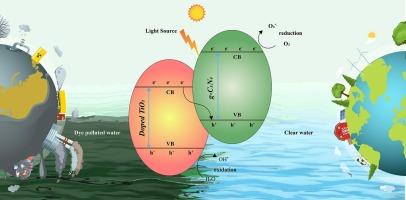Enhanced photocatalytic and photoelectrochemical performance of (Nb, Ta)-doped TiO2 modified g-C3N4 based Z-scheme heterojunction
IF 5.1
3区 材料科学
Q2 MATERIALS SCIENCE, COATINGS & FILMS
引用次数: 0
Abstract
The increasing demand for sustainable water treatment and energy generation solutions has led to escalating interest in the development of efficient photo/ electrocatalysts that harness solar energy. This study delves into the development of Titanium Dioxide (TiO2) doped with niobium (Nb) and tantalum (Ta), composited with graphitic carbon nitride (g-C3N4), for enhanced sunlight-driven photocatalytic and photoelectochemical (PEC) performance. The Nb/Ta doped TiO2 nanomaterials exhibit improved charge separation and good photocatalytic activity in the UV range, while the addition of g-C3N4 further enhances the overall photocatalytic efficiency and extended light absorption into the visible range. The structural studies by XRD show that the NbGCT with a crystallite size of 7.14 nm at (101) anatase plane which shows higher photo(electro)catalytic performance when compared with other composites used in this study. The peculiar findings from PL spectroscopy are that the enhanced PL intensity by demonstrating that the improved GCT produced more e−/h + couples. Also we found the reduction in band gap to 2.65 eV that extends to visible light absorption. The performance of all these composite was evaluated through PEC water splitting experiments and degradation of organic pollutants, showcasing ability of the optimal catalyst combination to perform as efficient material. The study also included detailed photo electrocatalytic analysis, focusing on the electrochemical properties of g-C3N4 modified Nb-doped TiO2 (NbGCT). NbGCT shows remarkable performance with the highest photocurrent density (1.39 mA cm−2) at the lowest onset potential (0.7 V vs. Ag/AgCl), suggesting that Nb doping is particularly effective in enhancing charge separation, light absorption, and photoactivity of the optimally modified sample. The results highlight the potential of g-C3N4 Modified (Nb, Ta)-doped TiO2 composite materials for efficient sunlight-driven applications such as water treatment and pollutant degradation.

(Nb, Ta)掺杂TiO2修饰g-C3N4基z型异质结的光催化和光电化学性能增强
对可持续水处理和能源生产解决方案的需求日益增长,导致人们对开发利用太阳能的高效光/电催化剂的兴趣不断上升。本研究研究了掺杂铌(Nb)和钽(Ta)的二氧化钛(TiO2),并与石墨化碳(g-C3N4)复合,以增强阳光驱动的光催化和光电化学(PEC)性能。Nb/Ta掺杂的TiO2纳米材料在紫外范围内表现出更好的电荷分离和良好的光催化活性,而g-C3N4的加入进一步提高了整体光催化效率,并将光吸收扩展到可见光范围。XRD结构研究表明,在锐钛矿(101)平面上,NbGCT晶粒尺寸为7.14 nm,与其他复合材料相比,具有较高的光(电)催化性能。从PL光谱中发现,改进后的GCT产生了更多的e - /h +对,从而增强了PL强度。我们还发现带隙减小到2.65 eV,延伸到可见光吸收。通过PEC水裂解实验和有机污染物降解实验对复合材料的性能进行了评价,证明了最佳催化剂组合作为高效材料的能力。本研究还进行了详细的光电催化分析,重点研究了g-C3N4修饰的nb掺杂TiO2 (NbGCT)的电化学性能。NbGCT表现出优异的性能,在最低起始电位(0.7 V vs. Ag/AgCl)下具有最高的光电流密度(1.39 mA cm−2),这表明Nb掺杂对优化修饰后的样品的电荷分离、光吸收和光活性特别有效。研究结果强调了g-C3N4修饰(Nb, Ta)掺杂TiO2复合材料在水处理和污染物降解等高效阳光驱动应用中的潜力。
本文章由计算机程序翻译,如有差异,请以英文原文为准。
求助全文
约1分钟内获得全文
求助全文
来源期刊

Diamond and Related Materials
工程技术-材料科学:综合
CiteScore
6.00
自引率
14.60%
发文量
702
审稿时长
2.1 months
期刊介绍:
DRM is a leading international journal that publishes new fundamental and applied research on all forms of diamond, the integration of diamond with other advanced materials and development of technologies exploiting diamond. The synthesis, characterization and processing of single crystal diamond, polycrystalline films, nanodiamond powders and heterostructures with other advanced materials are encouraged topics for technical and review articles. In addition to diamond, the journal publishes manuscripts on the synthesis, characterization and application of other related materials including diamond-like carbons, carbon nanotubes, graphene, and boron and carbon nitrides. Articles are sought on the chemical functionalization of diamond and related materials as well as their use in electrochemistry, energy storage and conversion, chemical and biological sensing, imaging, thermal management, photonic and quantum applications, electron emission and electronic devices.
The International Conference on Diamond and Carbon Materials has evolved into the largest and most well attended forum in the field of diamond, providing a forum to showcase the latest results in the science and technology of diamond and other carbon materials such as carbon nanotubes, graphene, and diamond-like carbon. Run annually in association with Diamond and Related Materials the conference provides junior and established researchers the opportunity to exchange the latest results ranging from fundamental physical and chemical concepts to applied research focusing on the next generation carbon-based devices.
 求助内容:
求助内容: 应助结果提醒方式:
应助结果提醒方式:


